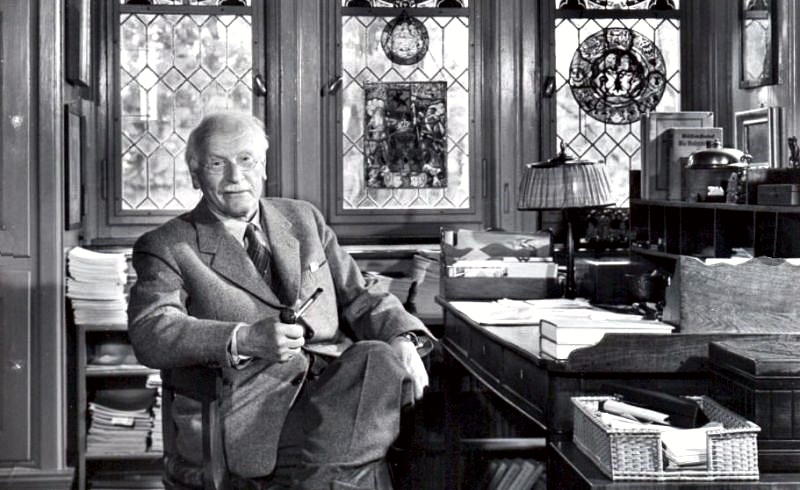
|
Home DH-Debate 6. Ten Rorchach Cards 8. Luscher's Color Personality Test |
| 1. Murray and Morgan | 2. TAT test |
| 3. Interpretation | 4. Test Behavior |
| 5. Ambition Level Test | 6. Litteratur |
Henry Murray originally studied biochemistry at Harvard University in Massachusetts, specializing in chicken embryos. But after reading Jung's "Psychological Types" in 1923, which had just been published in English, he took a deep interest in psychology.
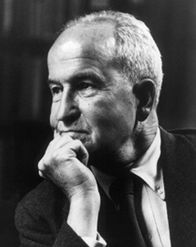
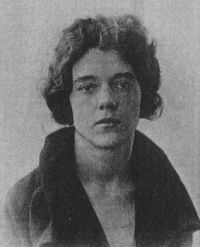
Left: Henry Murray 1893-1988.
Right: Christiana Morgan 1897-1967.
Less than a month later, a new turning point in his life occurred when, at a dinner party, he met a beautiful young woman named Christiana Morgan. She proved to be well versed in psychology and asked him if he preferred Freud or Jung. She encouraged him to travel to Switzerland to meet Carl Jung face to face.
During a stay in England, he spent an Easter holiday traveling to Lake Zurich in Switzerland meeting Carl Jung in person to discuss a possible career in psychology. For three weeks, Jung and Murray met daily in the town of Küsnacht on the shore of Lake Zurich. Murray recalled: "We talked for hours while sailing down the lake, smoking in front of the hearth in his Faustian retreat."
Shortly after returning to Harvard University in Massachusetts in the US, he succeeded in being appointed assistant professor of psychology. He quickly made a name for himself as a charismatic and dynamic psychologist, and in 1928 he was appointed director of the University's Psychological Clinic.

|
Carl Jung in his home in the town of Küsnacht on the shores of Lake Zurich in Switzerland. Photo The Astrology Podcast.
He hired Christiana Morgan and gave her an office in the clinic.
Both Henry Murray and Christiana Morgan were married, but not to each other. They nurtured an intense love affair for the rest of their lives. Henry rented a small apartment over a tobacco shop near the clinic, and almost daily they discreetly retreated there.
"Academic psychology has contributed practically nothing to the knowledge of human nature," he wrote in a controversial article. Murray's goal was "to understand man and the nature of man in all its phases" and in doing so he differed - at least apparently - from, for example, Freud, who was a physician and wanted to cure his patients who suffered of neuroses or other mental problems. Murray, on the other hand, was interested in normal people. His plan was to study 50 gifted Harvard students and map out their personalities completely.
Morgan and Murray tried to use the Rorschach test for this purpose, but found it unsuitable.
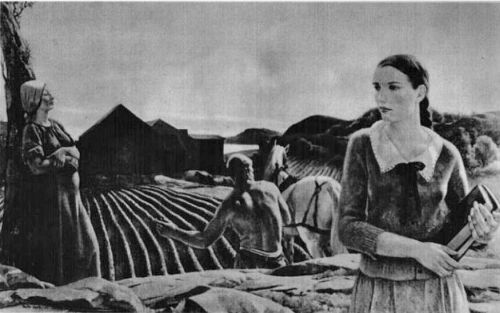
TAT picture 2. A woman holding a book in a rural landscape. In the background a man working in the field and another woman standing passively looking towards the horizon.
It is said that the card represents a group scene and and is intended to explore the individual challenge of living with other people. However, it is noticeable that the young woman in the foreground is nicely dressed and apparently engaged in bookish pursuits. The man, on the other hand, performs physically hard agricultural work, and the other woman stands in a position that suggests pregnancy. A story about the young ambitious woman who turns her back on her upbringing in the countryside and the prospect of an early marriage to get a bookish education is obvious.
He often quoted the philosopher George Santayana: "In man, imagination is more fundamental than perception." He and Jung were inspired by the Englishman Francis Galton, who in 1879 created a "word-association experiment", which consisted of writing seventy words on each piece of paper, and then draw a random note and noting the associations that this word created. Galton wrote: "No one can have just an idea before he carefully experimented upon himself, of the crowd of half-thoughts and faint imagery that flits through his brain and of the influence they exert upon his conscious life."
Carl Jung further developed Galton's idea with a list of words that he found particularly suitable for evoking associations, such as "mother", "kissing", "death" and "sinning".
Murray was convinced that the truth of human personality should be found in fantasies and daydreams laden with longing and desire. He wrote that "the real facts of human nature are be found - not on the surface of the body or in the full light of consciousness - but in the darker, blinder recesses of the psyche."
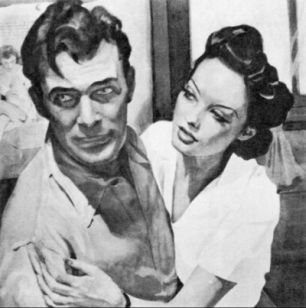
TAT image 4. A man turning away from a woman, who grabs him by the shoulders.
This card should explore the test person's feelings and attitudes towards the relationship between man and woman. In addition, it specifically aims to examine the test subject's relationship with other men, including rivalry between men and jealousy, as the man in the picture seems excited about something and the woman seeks to reassure him.
The word association test brought them closer to the truth, they thought, but they tried several other types of association tests, such as a "musical reverie test" in which the test person sat in a comfortable armchair and listened to music by Tchaikovsky and Mozart and at the same time had to report his associations thereby, and "the literary composition test" where the test person got a synopsis of a not too well known short story and then had to develop it into their own short story. They tried an "odor imagination test" in which the blindfolded test subject was exposed to various odors, including whiskey, violet perfume, aftershave lotion, gum eraser and Worcester Sauce. After each smell, he was asked to write a short anecdote or episode about it.
Murray and Morgan invented many other tests, but eventually a test stood out as the answer to their problems. It was to be named "Thematic Apperception Test", TAT. It was simply about showing the test takers some selected - relatively ambiguous - pictures and asking them to tell a little story about each.
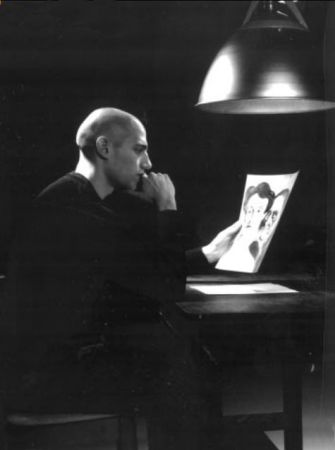
A TAT test situation. Photo Twitter.
It is a projective test, which means that the test taker is assumed to involuntarily identify with the protagonist of his narrative and thereby project his own unconscious motives, inner conflicts and longings into him or her. The interpretation of the test material can then say something about the test person's inner, unconscious life.
Unlike the inkblots, the TAT pictures are real pictures, which imagine something - but still not too much.
Murray and Morgan found motives for their TAT tests in magazines and journals such as "Women's Home Companion", "Life", "Time", "The Sportsman" and many more. They collected about two thousand drawings and photographs. Soon the whole building was filled with old magazines and periodicals. They showed the pictures to colleagues, students and family members to assess the motives' ability to evoke associations.
The requirements for the images were that they should contain a "hero" that the test person could identify with. They were to touch on some recognizable and universal human dilemmas. They should also be sufficiently vague and ambiguous to accommodate a test person's imaginations.
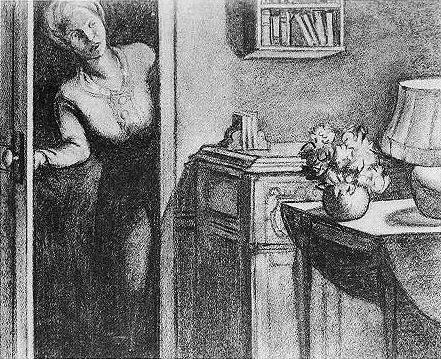
TAT picture 5. A woman looking into a room from the door.
This card is aimed to explore the test taker's relationship with his mother or wife. He can describe a loving mother or wife who carefully looks after her son or husband and tells that now the dinner is ready. Maybe she is surprised to see he is not in the room. Or he can describe a controlling, dominant woman who controls his life in detail. Or he may tell a story that he is secretly observed by strangers. Which last two stories will point to a martyr complex - possibly anxiety - or paranoia.
Together with MMPI and Rorschach, TAT has today become one of the most widely used psychological tests.
The test is intended to be used on individuals only - not on groups. It consists of 20 cards with images that represent something but are ambiguous. They are presented to the test person one by one in a predetermined order.
The cards are numbered from 1 to 20. Many of the numbers are added letters. Thus, 3BM means that card number 3 is suitable for "Boys" and "Males", 13MF means that card number 13 is suitable for "Males" and "Females" and 9GF means that card number 9 is suitable for "Girls" and " Females "and so on.
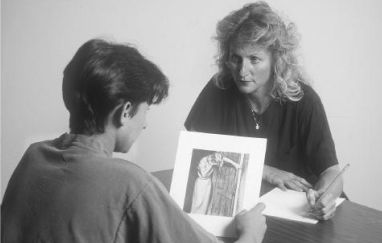
TAT interview. The persons are sitting wrongly. The psychologist must sit obliquely behind the test taker.
Depending on whether the test taker is a "boy", "male", "female" or "girl", different sequences are recommended in which the cards should be presented. A test taker can expect to be presented with 9-10 cards selected after gender and age.
If the test person is a man, he may be presented with the cards: 1, 2, 3BM, 4, 6BM, 7BM, 11, 12M, 13MF in this order.
If the test taker is a woman, she may meet the cards: 1, 2, 3, 3BM, 4, 6GF, 7GF, 9GF, 11, 13GF.
However, it is so that TAT is administered very differently, many new cards have been added since Murray and Morgan published their test in 1935, moreover, many individual psychologists have their own ideas about which and how many cards they will use.
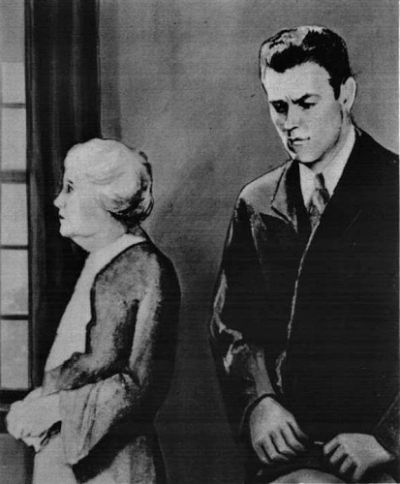
TAT image 6BM. An elderly woman stands with her back to a tall young man and looks out the window. He stands with his hat in his hand looking down. It is said that this image should explore the test taker's relationship with his mother and investigate guilt, dependence, disagreement and the like. However, one might think that a son would not be so formally dressed in front of his mother. The fact that he is standing with his hat in his hand suggests that he is coming from outside perhaps to convey a message to the woman. She looks away suggesting it's bad news. He looks politely and embarrassed down at the floor. Drawing by Christiana Morgan. Photo Psychestudy.
The test taker should sit right next to the examiner with his or her chair facing away. The time is measured separately for each image. The total time for 10 images is 50 minutes, that is 5 minutes for each image.
The test person must be based on four main points for each image:
- The current situation?
- The person's thoughts and feelings?
- What happened before?
- What will happen now?
During the test, the psychologist is only allowed to make encouraging remarks, which reflect the four points shown above. He may come up with questions such as: "What happened?"; "What events have taken place prior to this?", "What will happen to him (the main character) now?"; Or "What will happen later?". He must not provide real help.
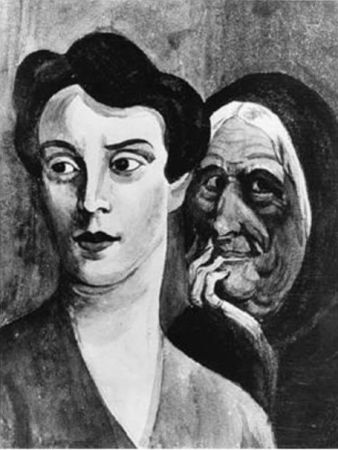
TAT image 12F shows a woman being observed from behind by an elderly woman. It is probably intended to explore the test taker's (a woman's) relationship to her mother. The younger woman looks towards the horizon with wide open eyes, perhaps she has made a big decision in her life that she thinks involves the realization of her dreams. The older woman is wiser but does not want to interfere.
The test subject's complete answer for each card will be recorded, presumably as tape recording. But basically, everything the test person says and does will be recorded, including stuttering, tone of voice, posture, twisting hands, exclamations and so on. It will be noted if the test taker seeks eye contact with the psychologist. It will be noted if he hesitates seeing special pictures.
The test aims to uncover the test taker's personality and hidden unconscious motives. It is said that it will also test the person's intellectual ability to structure a narrative with an introduction, an action and an ending.
The personality that the test person gives to the main character of the story will be interpreted as his own. The other characters will typically be interpreted as family or colleagues, and their relationship with the main characters in the story will be considered as the test-person's typical relationship with other people.
There is no formal scoring system for TAT - as there is in MMPI and Exner's system in Rorschach - and therefore analysis of TAT responses is often subjective.
I will use some self-invented responses on picture 1 as examples.
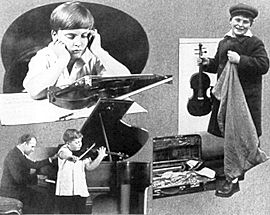
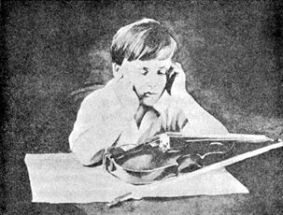
|
Left: A photograph of the famous violinist Menuhin as a boy.
Right: TAT picture 1. A boy looking at a violin.
This card is intended to provide information about the test taker's willingness to concentrate and gain higher competence. A test-taker's story, which describes the boy's reluctance to be forced to learn to play the violin, will score on a lack of ambitions.
A test taker's response to TAT picture 1. could say: "The boy found an old violin in the attic and liked to make some fun with it. It sounded awful, the cat rushed out of the house when he started, the neighbors rumbled on the wall. One day the boy was out playing, his mother threw the old useless violin in the trash, and then there became peace in the house. "
It is quite clear that the test taker identifies with the boy. The tone of the story is humorous and arrogant.
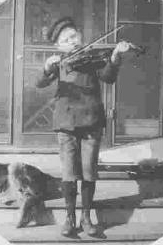
A boy plays the violin.
If the test-taker had eye contact with the psychologist and did not stutter or make nervous movements, and did not make excuses that he was not a good story-teller, it will reinforce the impression of arrogance, that is, the test-person has personal resources, but has a reluctance to make an effort and lacks ambition.
Another test taker's response to card 1 could say: "Ever since he was very young, the boy was very musical. Even before he could speak, he laughed excitedly every time he heard music and sat and jumped in time. When he became a little bigger, his grandfather bought him a violin. He practiced diligently for many hours every day. At an early age he was already very skilled and was admitted to a famous music conservatory. "
It is also clear here that the test taker identifies with the boy. The tone of this story is optimistic and straightforward. Together with the content of the story, it gives the impression of a serious and ambitious person.
Compared to MMPI and Rorschach, TAT does not have the same - relatively objective - fixed and detailed rules for scoring. Interpretation of the test subjects' responses is to a much greater extent left to the psychologist's subjective judgment. Therefore, it is very important to make a good impression on the psychologist and his possible assistants or secretaries without it seems affected or conspicuous.
Talk about the traffic or the weather, say that you think psychology is incredibly interesting or similar, or try to make the secretary smile.
It is wise to show a positive attitude towards the test - after all, psychology is immensely interesting - and do not criticize it or make funny remarks. Psychologists have no sense of humor when it comes to their tests. It will be perceived as arrogance.
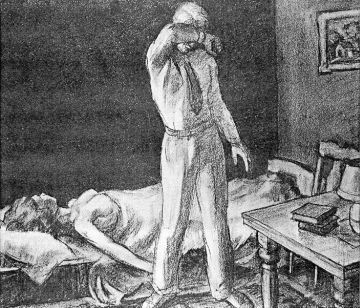
TAT image 13MF shows a seemingly lifeless naked woman in a bed. A fully clothed man with a tie takes to his head. This image is said to explore the test subject's sexual and aggressive feelings.
It may be his beloved wife who is burning with fever, the husband is worried because the doctor is not coming as promised.
The psychologist will encourage the test person to compose a kind of fiction. But one must clearly be warned against making an intriguing story that the man has just raped and strangled the woman, and now he takes to his head and thinks, what have I done? Remember that the protagonists of the stories are always identified with the test taker.
If the test-person goes to the test in silence with heavy steps, as if one was on the way to the guillotine, one will only give the impression that you have something to hide.
It is absolutely crucial to realize that this is not a test of creativity. TAT tests are meant to dig things out of our personality that we hardly enough even know we have. The companies have no desire to hire a new H. C. Andersen or Charles Dickens. If the applicant mistakenly assumes it for a creativity test and just runs out of the tangent, it can go completely wrong.
The test person's stories must be success stories. The boy or the animal, or whatever is on the image, must early set a big goal. Through deprivations and sufferings, they must strive for this goal until they finally succeed and they become rich or famous or both. Possible personal conflicts must ultimately be resolved in the end.
As can be seen, it can be difficult to maintain optimism; but remember that novel magazine stories always have happy ends.
The protagonists of the stories will be identified with the test taker, and the protagonist's relationships with other characters in the stories will be interpreted as his typical relationship to other people, especially colleagues. Therefore, the personal relationships between the protagonist and other agents in the stories should be good.
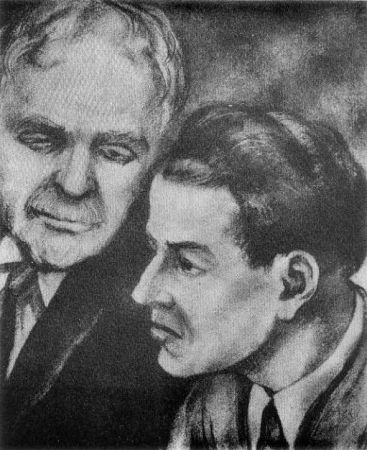
TAT picture 7BM with a younger man looking ahead and an older man looking at him. This picture is supposed to evoke the test person's attitudes and feelings towards authority figures.
One might think that it is two colleagues, an older and experienced and a younger and less experienced. The younger man looks in amazement at a phenomenon he has not experienced before, while his more experienced colleague explains to him what lies behind.
However, that is a completely unreasonable requirement for a poet. In all great stories, there are heroes and villains, and it is the intrigue created by the tension between them that makes the action unfold. The Three Musketeers fight against Mylady and Cardinal Richelieu, and Kulsoen is the Gønge-chief's arch-enemy. Only Robinson Crusoe faces nature itself, and Josef K confronts the anonymous and almighty court.
Bad relationships between the main character and other people in the test person's story should be temporary and due to mistakes.
Needless to say, it is wise to avoid controversial issues such as religion and politics - which does not make the poetry writing any easier.
The American psychologist, McClelland argued that humans have a fundamental need to accomplish something, big achievements, great feats and heroic deeds. In the same way, as we need food, water and shelter, we also need to perform achievements.
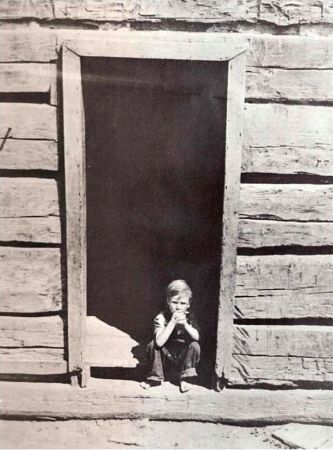
TAT picture 13B - A boy sitting in the doorway of a log cabin. Allegedly, the purpose of this card is to evoke the test person's feelings about loneliness. But, maybe the boy is just sitting and dreaming about all the feats and discoveries that he will make when he grows up, or maybe he exercises on his mouth harmonica.
He showed that there was a huge difference in the economic growth of society for different periods in history. In certain periods development seemed to make a tiger leap forward. For example England in the reign of Elizabeth 1. saw such a big marked growth, which only partly could be attributed to the new sea routes that have been discovered.
David McClelland studied the literature in the years up to major booms. He found that 40 to 50 years before a socio-economic tiger leap the literature contained many success stories. People dreamed really about to push the limits, to find new countries, to create new things, to perform achievements and become famous. The psychologist concluded that when Francis Drake and the other great explorers were children, their parents had been very concerned with achievements, and this fascination they had communicated down to their children.
Therefore, he believed that the economic boom in his time was due to that half a century ago children and adults dreamed about success.
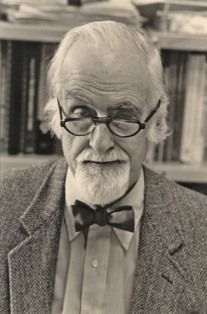
David McClelland 1917 - 1998.
The children's books of that time contained many success stories. For example, Tolkien's Bilbo Baggins traveled voluntarily out on a long and dangerous journey to search for treasures and finally, he really managed to find them.
Therefore, in order to ensure the future success for the society and the individual companies, it is important to assign such persons as new corporate employees, who have the greatest desire for achievements, who really want to accomplish something, to make a difference and get recognition for it.
To this end, McClelland developed a TAT-like test, an ambition level test, which he called "nACH" test. Later on, the test has been extended to also include need for power (nPOW) and need for affiliation (nAFF).
Following McClelland, a good manager must have a need for power. The idea of management is that the manager must realize his plans through his subordinates' actions, and to make this happen he needs power. Persons with too low desire for power may lack the self-confidence, which is necessary to organize and direct subordinates' activities efficiently. McClelland separates between "personalized power" and "socialized power".
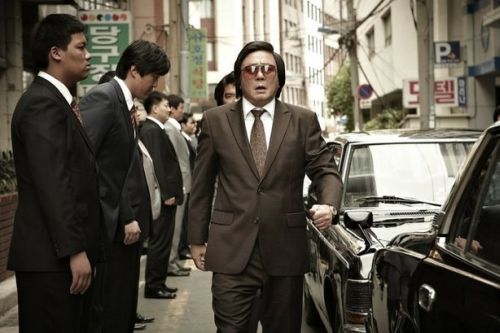
Manager with personal power.
Persons with a high need for personalized power may have few inhibitions and little self-control. They may have a tendency to be rude and they can exercise power impulsively. They are often characterized by excessive use of alcohol, inclined to sexual harassments, and they are often collecting symbols of power (e.g., big offices, large desks, impressive cars). When they give advice or support, it is with the strategic intent to further bolster their own status.
They demand personal loyalty from their subordinates rather than loyalty to the organization. When such leaders leaves office there is likely to occur breakdown of team morale and order.
Need for socialized power, however, is associated with effective leadership. Such managers use their power in socially positive ways that benefit others and the organization rather than contributing to the leader's status and personal gain. They are more hesitant to use power in manipulative ways, less narcissistic and defensive, they accumulate fewer symbols of power and status, have a longer time perspective and are more willing to receive advice. They know that power must be distributed and shared and that everyone must have a sense of influence over own jobs.

Affiliation between managers.
McClelland third factor is affiliation that is the ability to establish and maintain close and friendly relationships and take part in pleasant social activities. Greatly affiliated persons get great satisfaction from being liked and accepted by others. McClelland thinks that a good manager must have enough motivation and thus energy to keep close personal relations with peers and subordinates and maintain networking and public relations. However a manager cannot always make popular decisions that make everybody happy, therefore regarding affiliation, a good manager must be somewhat in between high and low in affiliation.
A person with a low score in affiliation tends to be a loner, who feels uncomfortable by socializing with others except for a few close friends.
Mcclealands test is designed to find the candidates best suited as managers. Its method is very similar to TAT. The test person is presented for four to six pictures, photos, that show some people, who are busy to perform some tasks. For example, an image can represent two men working at a machine.
The test person sees each image for about twenty seconds. He will then be asked to tell a story about the picture.

This may be a nAch picture - What will she do now? - tell a story.
In the same way, as in the TAT, the story should go on with the questions: "What happened?"; "What events occurred prior to this?"; "What will happen to him (the main character) now?"; "What will happen later?"
Again it is crucial to understand that it is not a creativity test, and it is not an intelligence test. This is a test to show whether the applicant in his personality is suited to be a manager.
A respons that characterizes a high level of ambition will be recognized by that the main character set up himself an appropriate target - not too high and not too low. He makes a plan that reaches into the future, with the intent to achieve this goal.
The ambitious candidate sets up a realistic goal which it is possible to achieve if he is making an effort.
A candidate, who sets up an idealistic high-flying target, will have revealed himself as not ambitious, he is only seeking an excuse for the fiasco, which he unconsciously expects.
A candidate, who sets up very easy and reachable objectives, will have revealed that his fear of failure overshadows his ambitions.
Test responses that are stories about attaining challenging goals, setting new records, successful completion of difficult tasks, doing something not done before, will all score on achievement.

This may be a nAch picture - What happened? - Write a story.
According to theory, an answer that reveals a low level of ambition may be characterized by that the main character gives in to pressure, he tries to avoid responsibility and thus fails in his efforts to achieve his goals.
To qualify as a manager in a large organization, one must have a moderate need for achievement, a strong need for power and a moderate need for affiliation. To qualify as a manager in smaller organizations, one must have a strong need for achievement, a strong need for power and a low need for affiliation, McClelland believes.
Stories that are about influencing others, defeating an opponent or competitor, winning an argumentation, or attaining a position of greater authority will all score on need for power.
Stories about eternal friendship, everlasting love, establishing or restoring close and friendly relationships, joining groups, participating in pleasant social activities, and enjoying shared activities with family or friends will score on affiliation.
Ricard Atkinson moderated McClelland ideas. He showed that we all balance our aspirations with our fear of failure. If we want to put a new motherboard in your computer or build a new carport, we will consider in advance, whether we have the right knowledge, the right tools and the right materials. Possibly, we may decide to abandon the project or leave it to a professional.
|
Department of Psychology
University of Tennessee Nogle TAT billeders oprindelse. Objectiv administration and scoring for the thematic apperception test Deparmento de Personalida Universidad de Salamanca. The Thematic Apperception Test – Science or Pseudoscience? "Great Plains Sceptic Thematic apperception test Wikipedia. Detailed Procedure of Thematic Apperception test Psychestudy. Projective Tests and Language Utpsyc. Murray's system of needs Wikipedia. Thematic apperception test Slideshare. "The Cult of Personality Testing" af Annie Murphy Paul. "Free Press" New York 2004. |
| To top |